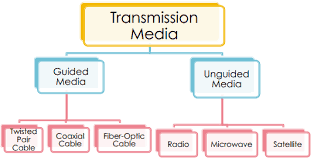Definition of Transmission Media in The Network Encyclopedia.
What is Transmission Media?
The term “Transmission Media” is a classification of the pathway that carries the information from a sender to a receiver according to its physical construction and transmission characteristics.

Examples of media include the following:
- Coaxial cabling
- Twisted-pair cabling
- Fiber-optic cabling
The term “media” can also refer to a combination of cabling and topology used for different types of Ethernet networks. Thus, for example, 10BaseT refers to a star topology using unshielded twisted-pair (UTP) cabling, while 10Base2 refers to a bus topology using thinnet cabling. You can loosely refer to these examples as 10BaseT and 10Base2 Ethernet media.
Transmission media is broadly classified into two groups:
- Wired or Guided Media or Bound Transmission Media
- Wireless or Unguided Media or Unbound Transmission Media
Wired Transmission Media
Guided transmission media are also called bounded media or wired media. They comprise cables or wires through which data is transmitted. They are called guided since they provide a physical conduit from the sender device to the receiver device. The signal traveling through these media are bounded by the physical limits of the medium.
The most popular guided media are:
Wireless Transmission Media
Unguided transmission media are also called wireless transmission media. They transport data in the form of electromagnetic waves that do not require any cables for transmission. These media are bounded by geographical boundaries. These type of communication is commonly referred to as wireless communications.
Unguided signals can travel in three ways:
- Ground propagation
- Sky propagation
- Line-of-sight propagation
The commonly used Wireless Transmission Media are:
- Radio transmission: These are easy to generate and can penetrate through buildings. The sending and receiving antennas need not be aligned. Frequency Range:3KHz – 1GHz. AM and FM radios and cordless phones use Radiowaves for transmission.
- Microwave transmission: It is a line of sight transmission i.e. the sending and receiving antennas need to be properly aligned with each other. The distance covered by the signal is directly proportional to the height of the antenna. Frequency Range:1GHz – 300GHz. These are majorly used for mobile phone communication and television distribution. (see wireless networking)
- Infrared transmission: Infrared waves are used for very short distance communication. They cannot penetrate through obstacles. This prevents interference between systems. Frequency Range:300GHz – 400THz. It is used in TV remotes, wireless mouse, keyboard, printer, etc.